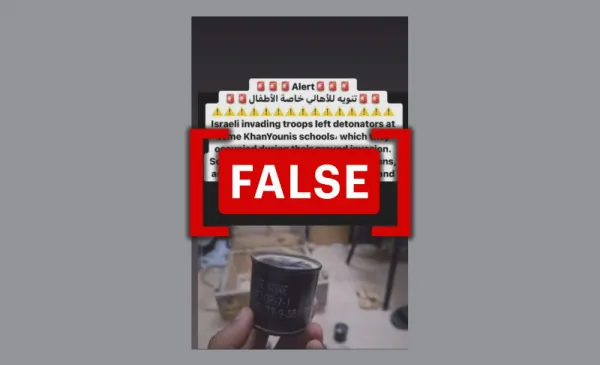By: John Faerseth
February 2 2024
 Source: Screenshot modified by Logically Facts
Source: Screenshot modified by Logically Facts
The cans are storage boxes for fuses. They do not explode when opened, and do not cause much damage if ignited.
Context
A video posted on Instagram on January 22, 2024, shows what appears to be a large number of metal cans. The caption reads, "Israel invading army left detonators at some Khan Younis schools, which they occupied during their ground invasion. Some children might think it's food cans, as soon as they are open thet (sic) detonate and kill instantly."
Several X users have also posted similar images, together with claims that Israel is deliberately dropping explosives looking like food cans as bait for starving Palestinians. Some have also claimed that civilians have been killed while trying to open them. The Palestinian news outlets Times of Gaza and Quds News Network have also repeated the claim.
However, the objects depicted are actually storage boxes for fuses for landmines and explosives and do not explode when opened.
In fact
According to a fact check by France 24, the cans depicted are storage containers for fuses that are used to ignite landmines. The website CAT-UXO, which specializes in explosives, writes that they are containers for American M603 igniter fuses made for use with M7A2 and M15 anti-vehicle landmines. When we enlarged a section of the clip and increased the light and contrast, the words "Fuze mine" became clearly visible on the label of one container.
The words "Fuze mine" can be seen on the label of a container (SOURCE: Screenshot modified by Logically Facts)
According to France 24, these fuses are in widespread use and could have been left both by Israel and Hamas.
Stein Helge Kingsrød, major in the Norwegian armed forces and head teacher at the Norwegian military academy, explains to Logically Facts that the fuse is designed for anti-vehicle mines and needs to be pushed down by a heavy vehicle to be ignited. A pressure between 70 and 120 kilograms is required for the Belleville spring to twist. The pressure needed is even larger, around 250 kilograms, when the fuse has been placed in a mine.
Kingsrød explains that when pressure is applied to the top of the fuse, the pressure is transferred to a so-called Belleville spring which then twists and drives a pin into a small detonator. According to Kingsrød, while the fuse contains a small amount of explosives, they are not enough to cause much damage by themselves, although it may be enough for a person to lose a finger. However, when the fuse is placed in the ignitor well of a land mine, the spurt is enough to ignite the explosives in the mine.
"Inside the storage container, which might resemble a very tiny soup can, although the fuse is only about 2.5 cm in diameter and about 2.5 cm tall, the fuse is equipped with a transport security system that blocks compression. This has to be removed with the help of a plier or some other tool. In other words, the cans do not explode when opened. In order for the fuse to explode, one has to squeeze it with a pressure of at least 70 kilograms. This is doable if one uses a vise, but not through ordinary handling," he says, adding that he speaks on a general basis and does not know whether the fuse is actually used in Gaza.
Due to Israel's long blockade of Gaza, a large part of the population was already dependent on humanitarian aid before the Israeli bombing and ground operation began after the October 7 Hamas attack. Since then, Israeli bombardment has damaged infrastructure, and an estimated 85 percent of the population is now displaced. According to a report by Human Rights Watch, Israeli forces are currently deliberately blocking the delivery of water, food, and fuel while willfully impeding humanitarian aid. As a result, most of the population is now on the brink of starvation.
The verdict
The cans are actually storage containers for fuses. While the fuses include a small amount of explosives, they need at least 70 kilograms of pressure to detonate. The explosives in the fuses are intended to ignite a landmine and are not enough to cause very much damage by themselves. The cans do not explode when opened. Therefore, we have marked this claim as false.